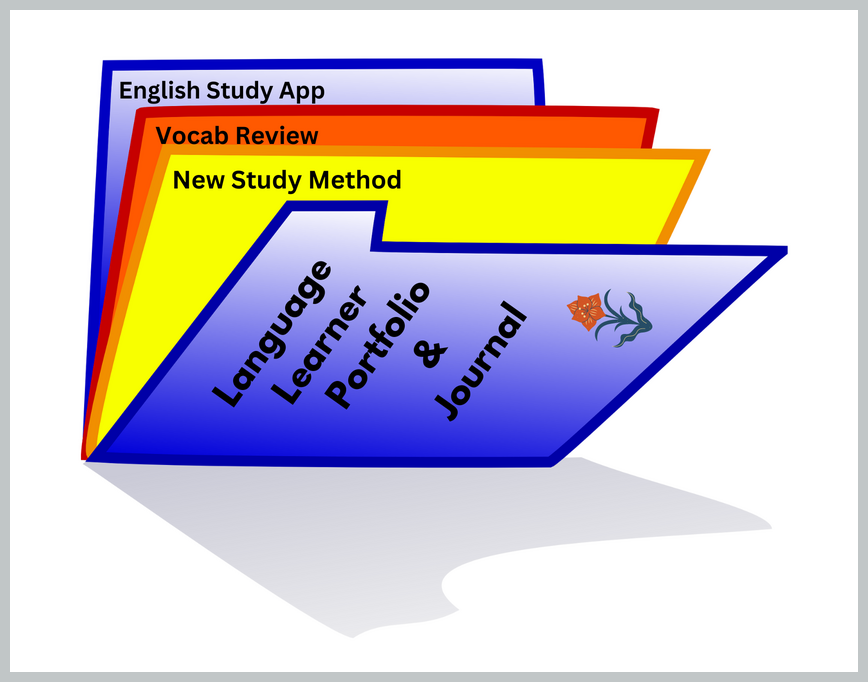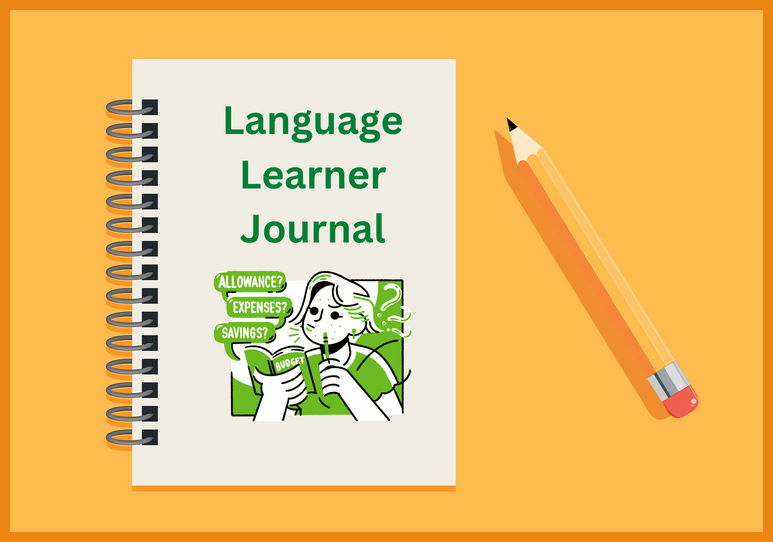Learner Journals and Portfolios for Language Improvement
By David E. Shaffer
Language learner journals and language learner portfolios have both been promoted individually as second language learning instructional tools for increasing motivation and self-direction in the language learner and thereby leading to better study practices. However, very little has been done to document their effectiveness and learner attitudes toward their use. Over the years, I have experimented with numerous ways of incorporating journal writing and portfolio-building into English skills courses at the university level. This article reports on a quite successful, combined journal-portfolio project with 76 university students over a one-semester period. Its purpose was to determine satisfaction with the project, its effectiveness in improving autonomous learning program design, and its effectiveness in improving autonomous study habits.
Students were asked to reflect in written English on the perceived effectiveness of their study methods and what they thought they might do differently to improve their individual English study program. In addition to their reflective writing, their journal-portfolios contained samples of the work that they did. Student attitudes toward the project were obtained through a questionnaire administered at the end of the project.
The results of the study revealed a positive change in student attitudes toward the project. They also felt that their study methods improved due to the project and that their communication skills improved through the project. Comparisons are drawn between this project and earlier, separate journal and portfolio projects. Finally, recommendations are made for incorporating a form of this project into a variety of English programs to aid learners in customizing their own language learning programs to fit their needs.
Education in Korea
Education in Korea has traditionally been teacher-designed, teacher-directed, teacher-centered, and test-driven. There were very few decision-making opportunities available to the student concerning their study. This is still true to a large extent in Korea’s current high school education system. Accordingly, many students enter the radically different university education system discovering that they need much more concentrated English language study than that built into the curriculum of required courses, but they are unsure as to how to go about it. They find themselves lost, directionless, not knowing exactly what to study or how to go about it. Consequently, they also become demotivated. As reflective learner journals and student portfolios have been promoted as both creating motivation and fostering autonomous learning, it was decided to examine their effectiveness as language learning tools to increase motivation and nurture self-direction in the English study of Korean university students.

Language Learning Journals
Journal writing is considered to be a beneficial mechanism to encourage students to be more critical and reflective in a growing body of research across a range of disciplines. Journals are able to provide a means for reflection before, during, and after a learning experience. Various studies have concluded that reflective journals help foster critical thinking and enhance learning by learners asking questions, engaging in higher order ideas, and making connections between theory and practice. It has also been recognized that journal writing holds great potential for enhancing learning in experiential education; university students have been more successful at thinking about and finding ways to make course material more relevant to their lives, applying the material to their lives, and finding ways to make the material more interesting. The effectiveness of the learning journal in generating motivation and directing autonomous English language learning in Korean university students was examined in Shaffer (2013) and is discussed here.
Language Learning Portfolios
The learner’s portfolio has been widely regarded as a tool that has the potential to increase student motivation as well as self-direction in one’s studies, providing the language learner with better study practices and providing the teacher with an additional assessment tool. One of the aims of the Shaffer (2013) study was to gauge the effectiveness of the learner’s portfolio in promoting motivation and self-directed learning for the English language learner at the university level in Korea. Those findings will also be discussed here.
Who, What, and How
Participants: The participants in the study were 76 EFL students at a large private university in Gwangju, Korea. The participants broke down into 17 male and 59 female students, and their average age was approximately 22 years old. All the participants were juniors or seniors majoring in an English language-related major.
Instrument: The instrument administered in the study was an online survey created through the web-based survey provider SurveyMonkey, administered at the end of the journal-portfolio project. The survey contained questions about the participants’ impressions of the language learning journal-portfolio project and about the contents, amount, and frequency of their journal writing and portfolio keeping. The journal- and portfolio-related questions were multiple-choice type, several with Likert-scale-type response choices. All survey items appeared in Korean so that the possibility of misunderstanding the items would be minimized.
Procedure: In a classroom situation, the participants were asked to keep a combined language learning journal and portfolio for 10 continuous weeks as part of the course requirement of their English oral-aural skills course. They were asked to include samples of their language learning methods and procedures in their portfolio and to describe and, very importantly, reflect on them in the journal portion. They were also asked to include a copy of their language learning study plan and schedule, and to also include any subsequent changes that they may have made to the plan. They were not given any minimum requirements for number or length of journal entries, or for number of portfolio items to include. They were informed that the main purpose of this journal-portfolio project was for them to reflect upon their individual language-learning practices, and through their reflection, to assess the effectiveness of each element of their language study program, and make adjustments to their study program as they felt necessary; examples were given by their instructor at the beginning of the project.
The participants were told that their journals and portfolios could possibly be checked during the semester, and it was stressed that the content was of primary importance, not the grammar or spelling of written text. During the semester, random spot-checking was carried out, students’ questions about the project were answered, and the journal-portfolios were collected and assessed at the end of the semester. It was at this time that the participants were instructed to complete the online survey concerning their journal-portfolio project.
Results of the Combined Journal-Portfolio Project

The most significant results of the post-project survey will be highlighted here. The majority of the participants (57.9%) made entries in their journals twice a week and 72.3% wrote between 100 and 599 words per week. Items were added to their portfolios 1–2 times a week by 79.0% of the participants. These results were in the range of production that the course instructor expected of the students.
The journal-portfolio project was considered successful due to participant responses to a number of the survey items. While 94.7% of the participants thought at the onset of the project that it would be beneficial, only 26.3% of them thought it would not be difficult. However, by the end of the project, 42.1% of the participants thought it was not difficult. Keeping a journal-portfolio was thought to be helpful in improving English study methods by almost all (96.1%) of the participants, helpful in improving English proficiency by 96.1%, and helpful in improving communication skills by 73.7%. A majority of the participants (52.6%) thought that their skills had improved more with the project than they would have without it, and 57.9% felt that their knowledge of language learning methods had improved more with the project than it would have without it. Two thirds of the participants (66.7%) thought it would be beneficial to do the journal project again in the following semester, and in addition, 57.8% responded that they planned to keep a journal-portfolio after the end of the course project.
Comparison with Dual Journal and Portfolio Project
The results of the combined journal-portfolio study (Shaffer, 2013) will here be compared with results of an earlier language learner journal project carried out concurrently but separately from a learner portfolio project with a different but similar group of university students (Shaffer, 2012). More participants in the present study (26.3%) thought that the journal-portfolio project was not difficult than participants who thought that the earlier journal writing project was not difficult (16.4%); hereafter, represented in the form “(26.3 vs 16.4%)”, as an example. More participants also thought that it was not difficult at the end of the project (42.1 vs 34.2%). More participants in the journal-portfolio project wrote 4–5 times per week (11.8 vs 1.4%), and more wrote over 300 words per week (35.6 vs 19.2%). More detailed study plans were included in the journal-portfolio project (81.6 vs 67.1%), and more changes to study plans were recorded in the journal-portfolio project (61.9 vs 49.3%). There were no instances in which the responses to a survey question were meaningfully more favorable to either the journal project or the portfolio project in the Shaffer (2012) study than they were to the combined journal-portfolio project in the 2013 study.
In Conclusion
The 2013 study has shown that the combination language learning journal-portfolio is an effective tool in helping Korean university students reflect on and make informed alterations to their individual language learning programs as a teacher-initiated but student-driven course project. It is projected that journal-portfolio keeping would also be effective in giving a reflective voice to the language learner in more autonomous language-learning environments and in allowing the learner to make informed alterations to their individual language learning programs. The results of this study lend support to Apple and Shimo (2005), Hamp-Lyons and Condon (2000), and Shimo (2003), who conclude that through language learner portfolio keeping (a) learners can reflect over their learning processes, (b) it is possible to make a continuous assessment over a long period of time, (c) learners can make original products, and they can feel a greater sense of achievement than with traditional tests, (d) learners can take control over their learning and feel more responsibility for it, and (e) learners can assess weaknesses and strengths in their own language learning, increase their proficiency, and set and reset goals more effectively by viewing their work.
Also shown in the 2013 study is that both student production and student attitudes towards journal and portfolio keeping are higher when the two tasks are combined into a single activity rather than being two concurrently executed, but separate, tasks. As most of the on-task time is spent out of class, the journal-portfolio project can easily and effectively be integrated into university student language learning programs, and become a language learning tool voluntarily employed by the student in their own language learning endeavors for reflection on and analysis of their language learning methods and strategies in order to make changes to their study practices and try out new methods for more effective language learning.
References
Apple, M., & Shimo, E. (2005). Learners to teacher: Portfolios, please! Perceptions of portfolio assessment in EFL classrooms. In T. Newfields (Ed.), Proceedings of the 2004 JALT Pan-SIG Conference (pp. 53–58). JALT Publications.
Hamp-Lyons, L., & Condon, W. (2000). Assessing the portfolio: Principles for practice, theory, and research. Hampton Press.
Shaffer, D. E. (2012, September). Language learning journal writing and portfolio projects: Efficacy and sustainability. In 2012 KAFLE International Conference Proceedings (pp. 383–394). KAFLE.
Shaffer, D. E. (2013, September). A journal-portfolio project for improvement of student-guided study. In 2013 PKETA International Conference Proceedings (pp. 265–275). PKETA.
Shimo, E. (2003). Learners’ perceptions of portfolio assessment and autonomous learning. In A. Barfield & M. Nix (Eds.), Learner and teacher autonomy in Japan 1: Autonomy you ask! (pp. 175–186). Learner Development Special Interest Group of the Japan Association of Language Teachers.
__________________________
Gwangju-Jeonnam KOTESOL Upcoming Events
December 10, 2022: Monthly Workshop and Year-End Party
Check the Chapter’s webpages and Facebook group periodically for updates on chapter events and other online and in-person KOTESOL activities.
For full event details:
- Website: http://koreatesol.org/gwangju
- Facebook: Gwangju-Jeonnam KOTESOL
The Author
David Shaffer has been involved in TEFL, teacher training, and research in Gwangju for many years. His research has been presented at over 200 international and domestic conferences. As vice-president of the Gwangju-Jeonnam Chapter of KOTESOL, he invites you to participate in the chapter’s teacher development workshops and events (online and in person) and in KOTESOL activities in general. He is a past president of KOTESOL and is currently the editor-in-chief of the Gwangju News.







